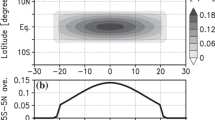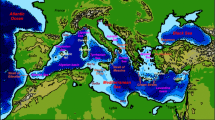Abstract
Ensemble simulations, using both coupled ocean–atmosphere (AOGCM) and atmosphere only (AGCM) general circulation models, are employed to examine the austral winter response of the Hadley circulation (HC) and stationary Rossby wave propagation (SRW) to a warming climate. Changes in the strength and width of the HC are firstly examined in a set of runs with idealized sea surface temperature (SST) perturbations as boundary conditions in the AGCM. Strong and weak SST gradient experiments (SG and WG, respectively) simulate changes in the HC intensity, whereas narrow (5°S–5°N) and wide (30°S–30°N) SST warming experiments simulate changes in the HC width. To examine the combined impact of changes in the strength and width of the HC upon SRW propagation two AOGCM simulations using different scenarios of increasing carbon dioxide (CO2) concentrations are employed. We show that, in contrast to a wide SST warming, the atmospheric simulations with a narrow SST warming produce stronger and very zonally extended Rossby wave sources, leading to stronger and eastward shifted troughs and ridges. Simulations with SST anomalies, either in narrow or wide latitude bands only modify the intensity of the troughs and ridges. SST anomalies outside the narrow latitude band of 5°S–5°N do not significantly affect the spatial pattern of SRW propagation. AOGCM simulations with 1 %/year increasing CO2 concentrations or 4 times preindustrial CO2 levels reveal very similar SRW responses to the atmospheric only simulations with anomalously wider SST warming. Our results suggest that in a warmer climate, the changes in the strength and width of the HC act in concert to significantly alter SRW sources and propagation characteristics.
















Similar content being viewed by others
Notes
NCEP-DOE Reanalysis 2 is available on: http://www.esrl.noaa.gov/psd/data/gridded/data.ncep.reanalysis2.html.
HADISST dataset is available on: http://www.metoffice.gov.uk/hadobs/hadisst/data/download.html.
References
Caballero R (2007) Role of eddies in the interannual variability of Hadley cell strength. Geophys Res Lett 34:L22705. doi:10.1029/2007GL030971
Caldeira K, Myhrvold NP (2013) Projections of the pace of warming following an abrupt increase in atmospheric carbon dioxide concentration. Environ Res Lett 8:034039
Deser C, Phillips AS (2009) Atmospheric circulation trends, 1950–2000: the relative roles of sea surface temperature forcing and direct atmospheric radiative forcing. J Clim 22:396–413
Franzke CLE, O’Kane TJ, Monselesan DP, Risbey JS, Horenko I (2015) Systematic attribution of observed Southern Hemisphere circulation trends to external forcing and internal variability. Nonlin Processes Geophys 22:513–525
Frederiksen JS, Frederiksen CS (1993) Southern Hemisphere storm tracks, blocking and low-frequency anomalies in a primitive equation model. J Atmos Sci 50:3146–3163
Freitas ACV, Ambrizzi T (2012) Changes in the austral winter Hadley circulation and the impact on stationary Rossby wave propagation. Adv Meteorol 980816:1–15. doi:10.1155/2012/980816
Freitas ACV, Frederiksen JS, Whelan J, O’Kane TJ, Ambrizzi T (2015) Observed and simulated inter-decadal changes in the structure of Southern Hemisphere large-scale circulation. Clim Dyn. doi:10.1007/s00382-015-2519-z
Frierson DMW, Lu J, Chen G (2007) Width of the Hadley cell in simple and comprehensive general circulation models. Geophys Res Lett 34:1–5, L18804. doi:10.1029/2007GL031115
Gabriel CJ, Robock A (2015) Stratospheric geoengineering impacts on El Niño/Southern Oscillation. Atmos Chem Phys 15:11949–11966
Gastineau G, Le Treut H, Li L (2008) Hadley circulation changes under global warming conditions indicated by coupled climate models. Tellus A 60:863–884
Gastineau G, Li L, Le Treut H (2009) The Hadley and Walker circulation changes in global warming conditions described by idealized atmospheric simulations. J Climate 22:3993–4013
Gordon HB, Rotstayn LD, McGregor JL et al (2002) The CSIRO Mk3 climate system model, technical paper 60, CSIRO atmospheric research
Gregory D, Rowntree PR (1990) A mass flux convection scheme with representation of cloud ensemble characteristics and stability-dependent closure. Mon Wea Rev 118:1483–1506
Hoskins BJ, Ambrizzi T (1993) Rossby wave propagation on a realistic longitudinally varying flow. J Atmos Sci 50:1661–1671
Hoskins BJ, Karoly DJ (1981) The steady linear response of a spherical atmosphere to thermal and orographic forcing. J Atmos Sci 38:1179–1196
Hu Y, Fu Q (2007) Observed poleward expansion of the Hadley circulation since 1979. Atmos Chem Phys 7:5229–5236
Johanson CM, Fu Q (2009) Hadley cell widening: model simulations versus observations. J Clim 22:2713–2725
Kanamitsu M, Ebisuzaki W, Woollen J, Yang S-K, Hnilo JJ, Fiorino M, Potter GL (2002) NCEP-DEO AMIP-II reanalysis (R-2). Bull Am Meteorol Soc 83(11):1631–1643
Kang SM, Polvani LM (2011) The interannual relationship between the latitude of the eddy-driven jet and the edge of the Hadley cell. J Clim 24:563–568
Lindzen RS (1994) Climate dynamics and global change. Annu Rev Fluid Mech 26:353–378
Lu J, Vecchi GA, Reichler T (2007) Expansion of the Hadley cell under global warming. Geophys Res Lett 34:L06805. doi:10.1029/2006GL028443
Lu J, Chen G, Frierson DMW (2008) Response of the zonal mean atmospheric circulation to El Niño versus global warming. J Clim 21:5835–5851
Lu J, Deser C, Reichler T (2009) Cause of the widening of the tropical belt since 1958. Geophys Res Lett 36:L03803. doi:10.1029/2008GL036076
Marshall GJ, Connolley WM (2006) Effect of changing Southern Hemisphere winter sea surface temperatures on Southern Annular mode strength. Geophys Res Lett 33:L17717. doi:10.1029/2006GL026627
Müller GV, Ambrizzi T (2007) Teleconnection patterns and Rossby wave propagation associated to generalized frosts over southern South America. Clim Dyn 29(6):633–645. doi:10.1007/s00382-007-0253-x
Müller GV, Berri GJ (2007) Atmospheric circulation associated with persistent generalized frosts in central-southern South America. Mon Weather Rev 135:1268–1289. doi:10.1175/MWR3344.1
O’Kane TJ, Risbey JS, Franzke C, Horenko I, Monselesan DP (2013a) Changes in the metastability of the midlatitude southern hemisphere circulation and the utility of nonstationary cluster analysis and split-flow blocking indices as diagnostic tools. J Atmos Sci 70:824–842
O’Kane TJ, Matear R, Chamberlain M, Risbey J, Sloyan B, Horenko I (2013b) Decadal variability in an OGCM Southern Ocean: intrinsic modes, forced modes and metastable states. Ocean Model 69:121
O’Kane TJ, Risbey JS, Monselesan DP, Horenko I, Franzke CLE (2015) On the dynamics of persistent states and their secular trends in the waveguides of the Southern Hemisphere troposphere. Clim Dyn. doi:10.1007/s00382-015-2786-8
Oort AH, Yienger JJ (1996) Observed interannual variability in the Hadley circulation and its connection to ENSO. J Clim 9:2751–2767
Phipps SJ (2006) The CSIRO Mk3L climate system model, Technical Report No. 3, Antarctic Climate and Ecosystems Cooperative Research Centre, Hobart, Tasmania, Australia. ISBN 1-921197-03-X
Phipps SJ (2010) The CSIRO Mk3L climate system model v1.2, Technical report No. 4, Antarctic Climate and Ecosystems CRC, Hobart, Tasmania, Australia. ISBN 978-1-921197-04-8
Phipps SJ, Rotstayn LD, Gordon HB, Roberts JL, Hirst AC, Budd WF (2011) The CSIRO Mk3L climate system model version 1.0: part 1—description and evaluation. Geosci Model Dev 4:483–509. doi:10.5194/gmd-4-483-2011
Phipps SJ, McGregor HV, Gergis J, Gallant AJE, Neukom R, Stevenson S, Ackerley D, Brown JR, Fischer MJ, van Ommen TD (2013) Paleoclimate data-model comparison and the role of climate forcings over the past 1500 years. J Clim 26:6915–6936. doi:10.1175/JCLI-D-12-00108.1
Polvani LM, Kushner PJ (2002) Tropospheric response to stratospheric perturbations in a relatively simple general circulation model. Geophys Res Lett 29(7):1–4. doi:10.1029/2001GL014284
Rayner NA, Parker DE, Horton EB, Folland CK, Alexander LV, Rowell DP, Kent EC, Kaplan A (2003) Global analyses of sea surface temperature, sea ice, and night marine air temperature since the late nineteenth century. J Geophys Res 108:1–37
Reichler TJ, Held IM (2005) Evidence for a widening of the Hadley cell. In: 17th AMS conference on climate: Variability and change, American Meteorological Society, Cambridge
Rind D, Perlwitz J (2005) The response of the Hadley circulation to climate changes, past and future. In: Diaz HF, Bradley RS (eds) The hadley circulation: Present, past and future. Kluwer Academic Publishers, Dordrecht, pp 399–435
Robert AJ (1966) The integration of a low order spectral form of the primitive meteorological equations. J Meteorol Soc Japan 44:237–244
Rotstayn LD (1997) A physically based scheme for the treatment of stratiform clouds and precipitation in large-scale models. I: description and evaluation of the microphysical processes. Q J R Meteorol Soc 123:1227–1282
Rotstayn LD (1998) A physically based scheme for the treatment of stratiform clouds and precipitation in large-scale models. II: comparison of modelled and observed climatological fields. Q J R Meteorol Soc 124:389–415
Rotstayn LD (2000) On the “tuning” of autoconversion parameterizations in climate models. J Geophys Res 105:15495–15507
Sardeshmukh PD, Hoskins BJ (1988) The generation of global rotational flow by steady idealized tropical divergence. J Atmos Sci 45:1228–1251
Seidel DJ, Fu Q, Randel WJ, Reichler TJ (2008) Widening of the tropical belt in a changing climate. Nat Geosci 1:21–24
Shimizu MH, Cavalcanti IFA (2011) Variability patterns of Rossby wave source. Clim Dyn 37:441–454
Tandon NF, Gerber EP, Sobel AH, Polvani LM (2013) Understanding Hadley cell expansion versus contraction: insights from simplified models and implications for recent observations. J Clim 26:4304–4321
Taschetto AS, Ambrizzi T (2012) Can Indian Ocean SST anomalies influence South American rainfall? Clim Dyn 38(7):1615–1628. doi:10.1007/s00382-011-1165-3
Tyrrell GC, Karoly DJ (1996) Links between tropical convection and variations of the extratropical circulation during TOGA COARE. J Atmos Sci 53(18):2735–2748
Vidyunmala V, Nanjundiah RS, Srinivasan J (2007) The effect of variation in sea-surface temperature and its meridional gradient on the equatorial and off-equatorial ITCZ in an aquaplanet general circulation model. Meteorol Atmos Phys 95:239–253
Wang W-C, Liang X-Z, Dudek MP, Pollard D, Thompson SL (1995) Atmospheric ozone as a climate gas. Atmos Res 37:247–256
Acknowledgments
A.C.V. Freitas acknowledges Fundação de Amparo à Pesquisa do Estado de São Paulo (FAPESP) for financial support (Grant 2012/14231-1) and CSIRO Oceans and Atmosphere for technical support. T.J. O’Kane is supported by an Australian Research Council Future Fellowship (FT120100008). T. Ambrizzi had partial support from CNPq (Grant 300976/2010-0), FAPESP (Grant 2008/58101-9) and VALE Technology Association Institute (ITV-VALE). This work is partly supported by the Australian Government Department of the Environment. We are grateful to Steven Phipps for the assistance with the CSIRO Mk3L model.
Author information
Authors and Affiliations
Corresponding author
Rights and permissions
About this article
Cite this article
Freitas, A.C.V., Frederiksen, J.S., O’Kane, T.J. et al. Simulated austral winter response of the Hadley circulation and stationary Rossby wave propagation to a warming climate. Clim Dyn 49, 521–545 (2017). https://doi.org/10.1007/s00382-016-3356-4
Received:
Accepted:
Published:
Issue Date:
DOI: https://doi.org/10.1007/s00382-016-3356-4




